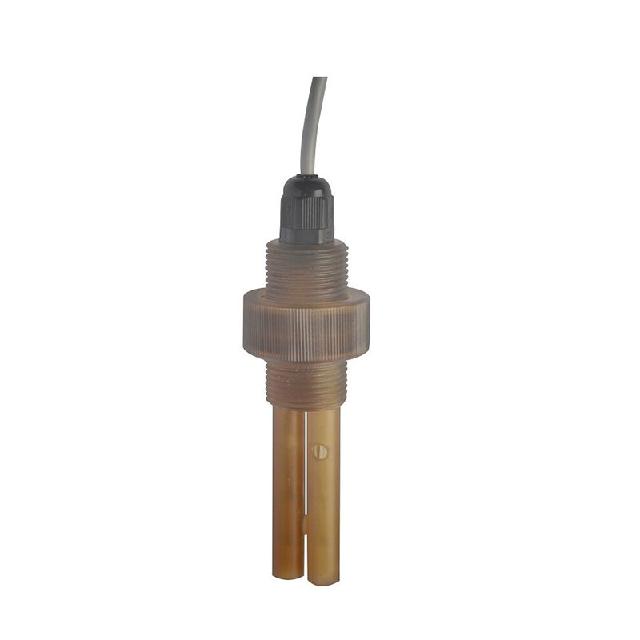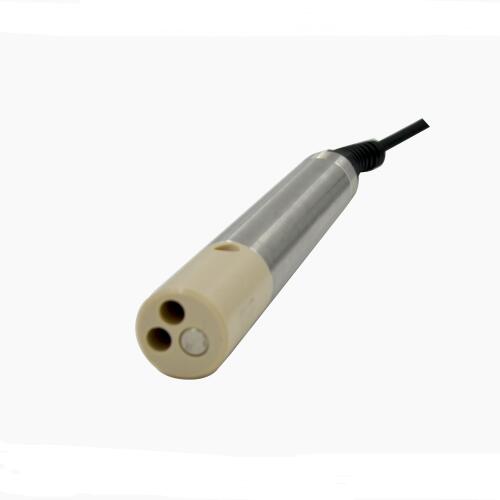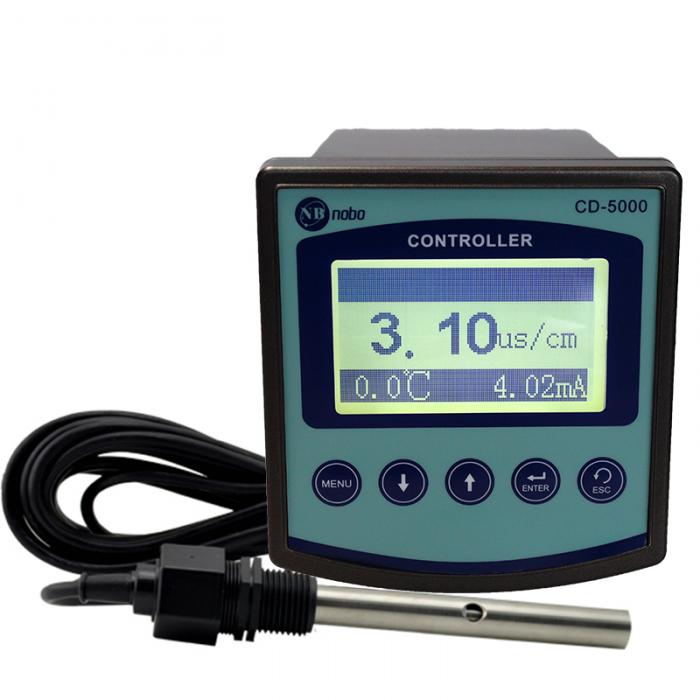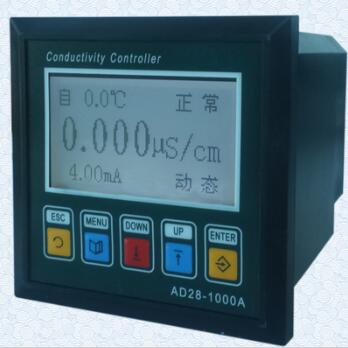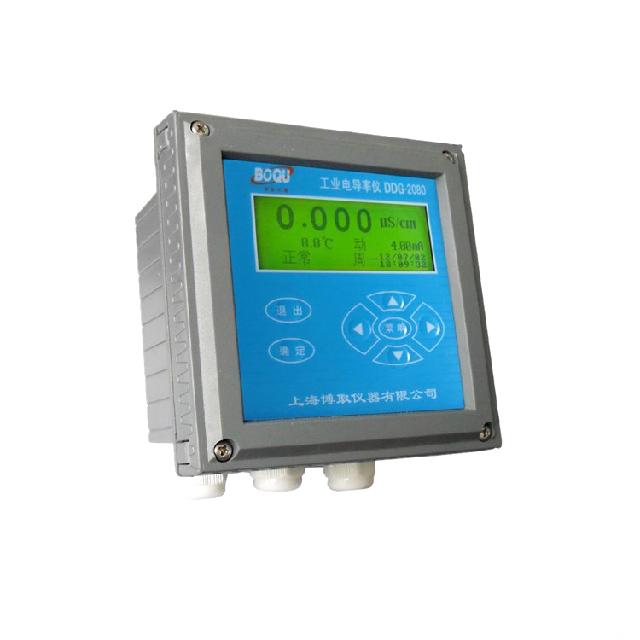| Name: | DDJ-10.0 online conductivity electrode |
|---|---|
| Measuring range: | 10~20000μS/cm |
| Working pressure: | 0-1.6MPa |
Measuring range | Electrode constant K | Model | Material | Process connectio |
0.01~20μS/cm | 0.01 | DDJ-0.01 |
316L, Titanium alloy | Pipe, flange Diameter: Φ6、Φ8、Φ12 |
0.1~200μS/cm | 0.1 | DDJ -0.10 |
316L, Titanium alloy | Pipe, flange Diameter: Φ6、Φ8、Φ12 |
1~2000μS/cm | 1.0 | DDJ -1.00 | 316L, Titanium alloy | 1/2", 3/4" thread |
10~20000μS/cm | 10 | DDJ -10.0 | 316L or Polysulfone | 3/4" thread |
30~600.0mS/cm | 30 | DDJ -30.0 | Polysulfone | 3/4" thread |
When measuring beyond the measuring range listed in the above table, the error will increase. When the dielectric conductivity value is >100μS/cm, it is advisable to use a platinum black electrode with a constant of 1.0 or 10 to increase the effective area and significantly reduce the current density on the electrode surface to effectively weaken the electrode that is easy to produce when the medium is a concentrated solution Polarized influence.
The electrode constant set in the meter must be consistent with the constant marked on the electrode. If the electrode constant marked on the matched electrode is 0.102, the electrode constant set in the meter must be 0.102.
Electrode installation
Electrodes usually have four installation methods: flow cell, immersion, pipeline, and flange.
1. The electrode adopts flow-through installation, which is suitable for the waterway connected by soft and hard pipes. The outer diameter of the inlet and outlet pipes has four specifications: φ6, φ8, φ10 and φ12, to meet the different needs of users. Generally equipped with φ10.
2. The electrode is installed by sinking, the electrode lead is passed out of the sheath tube, and then the thread on the top of the electrode is connected to the sheath tube.
3. Electrode pipeline installation, connect the thread of the electrode front end to the pipeline (optional welding head). Use a 3/4 thread welding head to weld on the pipe, and then screw the electrode into the welding head. If necessary, wrap some raw material tape on the electrode thread to prevent water from overflowing.
Note: The electrode must be screwed to the pipe first, but the cable and the electrode must be turned in the same direction to prevent the internal wire of the cable from being twisted when the electrode is screwed separately. When you want to check it down, first remove the cable from the meter, and then screw the electrode. This is to prevent the wire from being twisted at the connection between the electrode and the cable.
Fourth, the electrode is installed with a flange, and the flange plate is configured according to customer requirements, such as DN80, DN100, etc.
Note: In general, it is configured according to flow-through installation.
Electrode description
1. The conductivity cell needs to be cleaned in time. Clean with 50% warm detergent (for the dirt with strong adhesion, 2% hydrochloric acid or 5% nitric acid solution can be used to soak and clean), brush with nylon brush, and then rinse the inner and outer surfaces of the electrode with distilled water repeatedly. Remember to touch the electrodes with your hands.
2. The lead of the electrode and the connecting plug at the back of the secondary meter should not get wet, otherwise the measurement will be inaccurate.
3. The high-purity water should be measured quickly after being put into the container. Because the CO2 in the air will continue to dissolve in the water sample to form carbonate ions with strong conductivity, the conductivity will continue to rise, and the measured data will be inaccurate.
4. The container of the tested solution must be clean and free of ion contamination.
5. Improper use of electrodes often causes the instrument to work abnormally. When installing the electrode, the electrode should be completely immersed in the solution.
6. There are other special requirements, please specify.
The basic principle of electrode selection: According to the size range of the measured water sample conductivity, refer to the table below to select an electrode with an appropriate constant. When choosing electrodes, the most common mistake is "choose a large constant electrode to measure low conductance". If you choose the 1.0 electrode to measure the water sample <3μS/cm, it is impossible to get an accurate value. Because the conductivity of the low-conductivity medium is very poor, if you use a large constant electrode to measure, you will only get a weaker and unstable electrical signal, which is bound to greatly increase the measurement error.
K=0.1 Compression type electrode Pipe type threaded electrode K=0.01 Screw type electrode Compression plug-in electrode Polysulfone K=10/30
DDJ-0.01, 0.1, 1.0, 10.0, 30.0 five kinds of conductivity electrodes, specially used in a dedicated online industrial ion chromatography analysis and measurement of water conductivity device. The conductivity electrode is composed of inner electrode, outer electrode, temperature probe, electrode cup, top cover, and terminal. The inner electrode and outer electrode are ring-shaped, and the outer electrode is set outside the inner electrode and separated by insulating material; The lower end of the electrode is closed, and the outer electrode has a hole to allow water to flow through the gap between the inner electrode and the outer electrode; the temperature measuring probe is placed in the inner electrode; the inner electrode and the outer electrode are installed in the electrode cup and fixed to the lower end of the top cover , The electrode cup is equipped with water inlet and outlet pipes; the top cover is installed on the electrode cup; the terminal is installed on the upper end of the top cover; the inner electrode and the outer electrode are respectively connected to the terminal by wires; the gap between the inner electrode and the outer electrode is Between 1-2 mm. The conductivity electrode uses the gap between two concentric electrodes to measure the conductivity of water, and the gap between the two electrodes is controlled within the range of 1-2 mm.

